Caihua
Caihua (Chinese: 彩画; pinyin: cǎihuà), or "colour painting", is the traditional Chinese decorative painting or polychrome used for architecture and one of the most notable and important features of historical Chinese architecture. It held a significant artistic and practical role within the development of East-Asian architecture, as Caihua served not only decoration but also protection of the predominantly wooden architecture from various seasonal elements and hid the imperfections of the wood itself. The use of different colours or paintings would be according to the particular building functions and local regional customs, as well as historical periods. The choice of colours and symbology are based on traditional Chinese philosophies of the Five Elements and other ritualistic principles. [1][2] The Caihua is often separated into three layer structures; timber or lacquer layer, plaster layer, and pigment layer.
| Caihua | |||||||
|---|---|---|---|---|---|---|---|
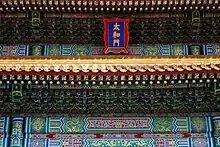 Chuanzi-style Caihua of the Forbidden City | |||||||
| Traditional Chinese | 彩畫 | ||||||
| Simplified Chinese | 彩画 | ||||||
| Literal meaning | "Colour-painting" | ||||||
| |||||||
History
The origins of Caihua can be traced back to the Zhou dynasty,[3][4] as the Zuo Zhuan and Guliang Zhuan detailed:
“秋,丹桓宮楹。禮,天子、諸侯黝堊,大夫倉,士黈,丹楹,非禮也。[5] (the duke painted red the pillars of [duke] Huan's temple. According to rule, King and royalty use dark and white, gentry use white, yeoman use yellow. Red pillars are against etiquette.)
. The Rites of Zhou similarly records a ritualistic usage of motifs and colour, based on each respective aspects' corresponding symbolic value.
"画缋之事:杂五色。东方谓之青,南方谓之赤,西方谓之白,北方谓之黑,天谓之玄,地谓之黄。青与白相次也,赤与黑相次也,玄与黄相次也。 青与赤谓之文,赤与白谓之章,白与黑谓之黼,黑与青谓之黻,五采备谓之绣。土以黄,其象方,天时变;火以圜,山以章,水以龙;鸟,兽,蛇。杂四时五色之位以章之,谓之巧。凡画缋之事,后素功"[6]
Gallery
 Song Dynasty "Wucai Caihua" (Five Coloured Painting)-decorations guide as detailed on the Yingzao Fashi
Song Dynasty "Wucai Caihua" (Five Coloured Painting)-decorations guide as detailed on the Yingzao Fashi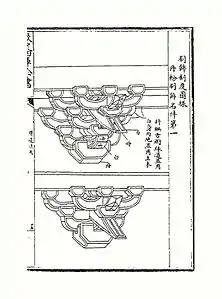 Song Dynasty "Danfen Caihua" (Red and White)-decorations guide as detailed on the Yingzao Fashi.
Song Dynasty "Danfen Caihua" (Red and White)-decorations guide as detailed on the Yingzao Fashi.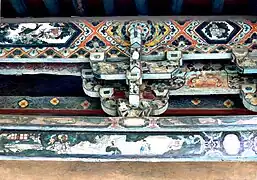 Caihua found on Jinci temple, Song Dynasty.
Caihua found on Jinci temple, Song Dynasty.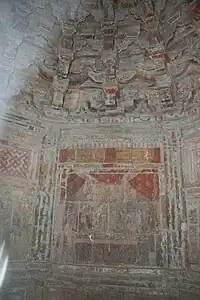 Frescos of Song Silang's Tomb, Northern Song Dynasty.
Frescos of Song Silang's Tomb, Northern Song Dynasty.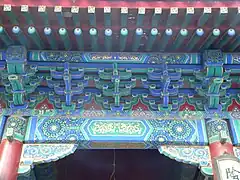 "Xuanzi"-style decorative design on the Beijing Dongyue Temple
"Xuanzi"-style decorative design on the Beijing Dongyue Temple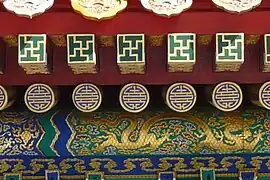 Caihua found on the Gate of Heavenly Purity of the Forbidden City
Caihua found on the Gate of Heavenly Purity of the Forbidden City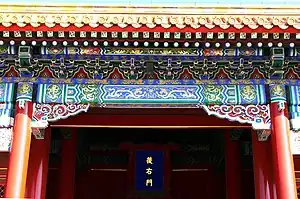 "Hexi"-style decorative design on the Imperial Palace gate of the Forbidden City
"Hexi"-style decorative design on the Imperial Palace gate of the Forbidden City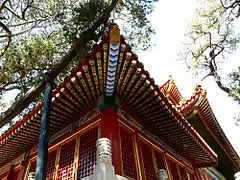 Underside decorations of Qin'an Hall of the Forbidden City
Underside decorations of Qin'an Hall of the Forbidden City Painted mural depicting an event from Journey to the West on the Long Corridor from Qing Dynasty Summer Palace
Painted mural depicting an event from Journey to the West on the Long Corridor from Qing Dynasty Summer Palace
See also
References
- 孙大章 (1991). 中国古代建筑彩画 [Ancient Chinese Architectural Colored Drawings] (in Chinese). 建筑工业出版社. ISBN 7-112-07328-6.
- 赵双成 (2006). 中国建筑彩画图案 [Chinese architecture painting design] (in Chinese). 天津大学出版社. ISBN 978-7561822494.
- 刘敦桢 (Liu Dunzhen) (1991). 中国古代建筑史 [History of Chinese Ancient Architecture] (2 ed.). 中国建筑工业出版社; 第2版 (China Architecture Building Press). ISBN 9787112019298.
- Flags, color, and the legal narrative : public memory, identity, and critique. Anne Wagner, Sarah Marusek. Cham, Switzerland: Springer. 2021. p. 129. ISBN 978-3-030-32865-8. OCLC 1253353500.
{{cite book}}: CS1 maint: others (link) - 穀梁子. . Vol. 莊公, 二十三年 – via Wikisource.
- . Vol. 6, 冬官考工记 – via Wikisource.